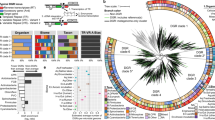Abstract
Restriction-modification (RM) systems are cognate gene complexes that code for an endonuclease and a methylase. They are often thought to have developed in bacteria as protection against invading genetic material, e.g., phage DNA. The high diversity of RM systems, as observed in nature, is often ascribed to the coevolution of RM systems (which ‘invent’ novel types) and phages. However, the extent to which phages are insensitive to RM systems casts doubts on the effectiveness of RM systems as protection against infection and thereby on the reason for the diversity of RM systems. We present an eco-evolutionary model in order to study the evolution of the diversity of RM systems. The model predicts that in general diversity of RM systems is high. More importantly, the diversity of the RM systems is expressed either at the individual level or at the population level. In the first case all individuals carry RM systems of all sequence specificities, whereas in the second case they carry only one RM system or no RM systems at all. Nevertheless, in the second case the same number of sequence specificities are present in the population.
Similar content being viewed by others
References
Barcus, V. A. and N. E. Murray (1995). Barriers to recombination: restriction, in Population Genetics of Bacteria, S. Baumberg, J. P. W. Young, S. R. Saunders and E. M. H. Wellington (Eds), Cambridge, U.K.: Cambridge University Press, pp. 31–58.
Bickle, T. A. and D. H. Kruger (1993). Biology of DNA restriction. Microbiol. Rev. 57, 434–450.
Frank, S. A. (1994). Polymorphism of bacterial restriction-modification systems: the advantage of diversity. Evolution 48, 1470–1477.
Hantula, J., A. Kurki, P. Vuoriranta and D. H. Bamford (1991). Ecology of bacteriophages infecting activated sludge bacteria. Appl. Environ. Microbiol. 57, 2147–2151.
Havelaar, A. H., K. Furuse and W. M. Hogeboom (1986). Bacteriophages and indicator bacteria in human and animal faeces. J. Appl. Bacteriol. 60, 255–262.
Johansen, A. (1996). A simple model of recurrent epidemics. J. Theor. Biol. 178, 45–51.
Korona, R., B. Korona and B. R. Levin (1993). Sensitivity of naturally occurring coliphages to type I and type II restriction and modification. J. Gen. Microbiol. 139, 1283–1290.
Korona, R. and B. R. Levin (1993). Phage-mediated selection and the evolution and maintenance of restriction-modification. Evolution 47, 556–575.
Kruger, D. H. and T. A. Bickle (1983). Bacteriophage survival: multiple mechanisms for avoiding the deoxyribonucleic acid restriction systems of their hosts. Microbiol. Rev. 47, 345–360.
Kulakauskas, S., A. Lubys and S. D. Ehrlich (1995). DNA restriction-modification systems mediate plasmid maintenance. J. Bacteriol. 177, 3451–3454.
Levin, B. R. (1988). Frequency-dependent selection in bacterial populations. Phil. Trans. R. Soc. Lond. B. Biol. Sci. 319, 459–472.
Monod, J. A. (1992). Theoretical implications for the evolution of postsegregational killing by bacterial plasmids. Am. Naturalist 139, 677–689.
Naito, T., K. Kusano and I. Kobayashi (1995). Selfish behavior of restriction-modification systems [see comments]. Science 267, 897–899.
O’Neill, M., A. Chen and N. E. Murray (1997). The restriction-modification genes of Escherichia coli K-12 may not be selfish: they do not resist loss and are readily replaced by alleles conferring different specificities. Proc. Natl. Acad. Sci. USA 94, 14596–14601.
Pagie, L. and P. Hogeweg (1999). Colicin diversity: a result of eco-evolutionary dynamics. J. Theor. Biol. 196, 251–261.
Proctor, L. M. and J. A. Furhman (1990). Viral mortality of marine bacteria and cyanobacteria. Nature 343, 60–62.
Redaschi, N. and T. A. Bickle (1996). Dna restriction and modification systems, in Escherichia Coli and Salmonella: Cellular and Molecular Biology, 2nd edn, Vol. 1, Chap. 52, F. C. Neidhardt (Ed.), Washington, DC: American Society for Microbiology, pp. 773–781.
Savill, N. J., P. Rohani and P. Hogeweg (1997). Self-reinforcing spatial patterns enslave evolution in a host-parasitoid system [published erratum appears in J. Theor. Biol. (1997) Oct 21; 188: 525–526]. J. Theor. Biol. 188, 11–20.
Sharp, P. M. (1986). Molecular evolution of bacteriophages: evidence of selection against the recognition sites of host restriction enzymes. Mol. Biol. Evol. 3, 75–83.
Wilson, G. G. and N. E. Murray (1991). Restriction and modification systems. Ann. Rev. Genet. 25, 585–627.
Author information
Authors and Affiliations
Rights and permissions
About this article
Cite this article
Pagie, L., Hogeweg, P. Individual-and population-based diversity in restriction-modification systems. Bull. Math. Biol. 62, 759–774 (2000). https://doi.org/10.1006/bulm.2000.0177
Received:
Accepted:
Issue Date:
DOI: https://doi.org/10.1006/bulm.2000.0177




